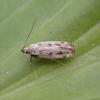35.097 Gelechia rhombella ([Denis & Schiffermüller], 1775)
Status and Distribution
Local in central and southern England, very local elsewhere in England and Wales. In Ireland it is referred to in Beirne (1941) as being noted in two eastern Irish localities in the 1860s. Two historic records from central Scotland require confirmation.

Provisional map
Foodplant and Larval Feeding Signs
Malus sylvestris (crab apple), see plant distribution map, Malus spp. (apple) and Pyrus communis (pear). In Europe possibly also on Prunus domestica (wild plum) and Sorbus.
In spun leaves folding down the leaf edge or in a flat spinning between two leaves. In Europe it has been noted as folding a leaf to form a pod.
Habitat
Orchards, gardens, hedgerows, parkland and open deciduous woodland.
Finding the Moth
Larva: in spun leaves folding down the leaf edge or in a flat spinning between two leaves. In Europe has been observed folding a leaf to form a pod.
Adult: can be beaten from the foodplant by day and comes to light.
Similar Species
The combination of a pale forewing, two prominent black spots in the centre of the wing and an elongate black spot at the base of the costa (leading edge) make this a distinctive species. Darker forms are known on the continent.
Other species which have the black spot or patch at the base of the costa are Gelechia hippophaeella, which is generally larger (wingspan 15-18mm as opposed to 12-16mm) and lacks the prominent spots in the centre of the forewing, and pale forms of Carpatolechia decorella which is generally smaller with black stripes rather than spots usually commencing further along the forewing.
Single brooded, during July and August.
Earliest: 27th June 1966 (VC21)
Latest: 12th September 2002 (VC37)






